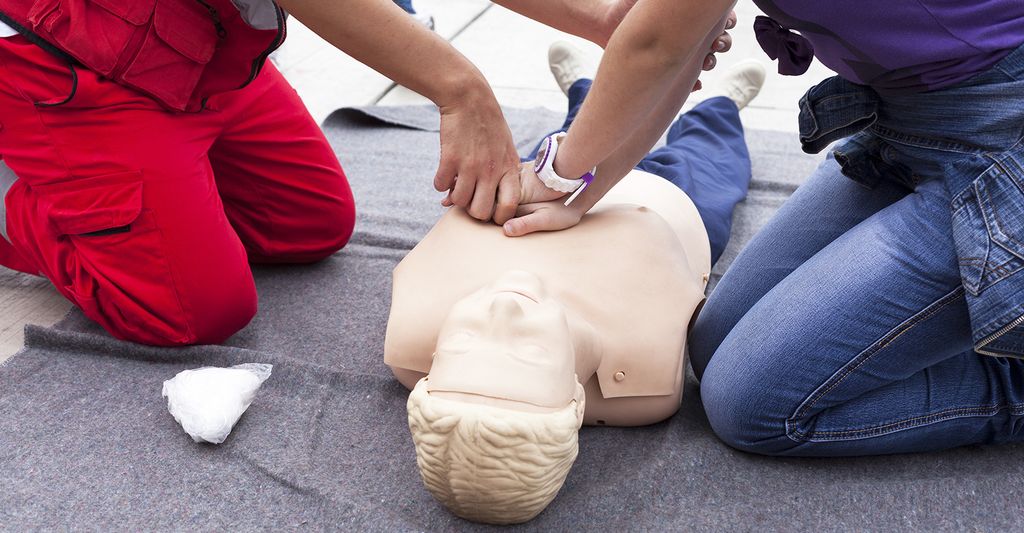What is CPR training?
Cardiopulmonary resuscitation (better known as CPR) is a lifesaving manual technique that pumps oxygenated blood back into the body’s organs if someone’s heart or breathing has stopped. A variety of CPR training is available to community members, employees and healthcare providers. CPR training may last two to five hours or more, depending on the content and the target audience. During the training, students will learn how to recognize and respond to an emergency situation. There are different CPR techniques for adults and children, but with both you will learn how to determine whether the person is conscious before administering chest compression. During the training you’ll learn chest compression techniques for adults and different techniques for children between the ages of 1 and 8. Students learn how to properly administer chest compressions, when the technique is appropriate and when it is not, and how long you must perform rescue measures. Students also learn what an automatic external defibrillator (AED) is and how to use it if necessary to shock a patient before administering CPR chest compressions.
How do I become CPR and first aid certified?
You can earn CPR training and receive first aid certification in a number of ways. Choose an online course to learn the materials remotely and then find a testing location to complete the certification process with an in-person demonstration of your knowledge and skills. Encourage your workplace to host a first aid and CPR training so employees can learn what to do in case of a workplace emergency and how to respond with lifesaving techniques. You may also be able to take a CPR or first aid class in your community. A basic CPR training may run four to five hours. After receiving CPR training, you’ll know how to respond if an adult or a child goes into cardiac arrest or stops breathing. You’ll learn how to use chest compressions to keep blood pumping to a person’s organs, which can keep them alive until an emergency responder can arrive. First aid and CPR training can also include education about how to use an automated external defibrillator (AED).
How long is your CPR certification good for?
In general, CPR training sessions and certifications are good for two years. After that, you must recertify to ensure you are up to date on the latest information and techniques. CPR is a lifesaving skill for a community member, employee or healthcare provider to know, as it enables you to respond appropriately if someone goes into cardiac arrest or stops breathing. In a CPR training, students learn compression techniques to keep blood flowing to the body’s organs if a person’s heart has suddenly stopped or they have stopped breathing. This action can keep a person alive until an emergency responder can arrive on the scene and can effectively save a life.
The American Red Cross explains that re-certification is important, because people start to forget information just a few months after taking a training. The American Red Cross recommends you keep your skills fresh by reviewing free, online materials or downloading their free, mobile app to keep abreast of CPR information and news. Re-certification courses are shorter than first-time CPR training. Your renewed CPR certification will be good for another two years.
How much does it cost to get CPR and first aid certified?
Request estimates from local pros to find out how much you'll pay for CPR and first aid training. Trainings are available to individuals who want to learn how to respond in case of an emergency and for healthcare providers who need to renew their certification. Typically, CPR certifications are current for two years.
What can you do with a first aid certificate?
People with a first aid certificate are trained to respond quickly and appropriately in life-threatening situations. Although a first aid certificate alone isn’t enough to secure a job, it can make you more attractive to certain types of potential employers. When you have a first aid certificate, you’ve proved that you know how to administer cardiopulmonary resuscitation (CPR), use an automated external defibrillator (AED), and handle emergency situations like choking, heavy bleeding, a heart attack or stroke, or anaphylaxis. Most parents prefer babysitters and lifeguards with first aid certification. Many professionals, especially those who work with children, are required to have first aid training, including teachers, coaches, counselors and therapists, firefighters, and social workers. In addition to adult and pediatric first aid plus CPR and AED courses, you can take first aid training specifically designed for babysitting and child care, for health care settings, and for swimming and water safety situations..
What do you learn in a first aid course?
First aid training gives you a variety of lifesaving skills for responding to many different emergency situations. In a first aid course you’ll learn about how to examine someone who’s been hurt, how to use a defibrillator, how to administer cardiopulmonary resuscitation (CPR), and how to control bleeding and trauma. Some courses include pediatric first aid as well as adult first aid; helping a choking infant, for example, is different from helping a choking adult. Although you can take CPR and automated external defibrillator (AED) courses separately, most first aid training includes both.
In a first aid course you’ll also learn how to respond to:
Wounds, including punctures, cuts and hemorrhages
Heart attacks, chest pain and respiratory arrest
Bone fractures, sprains and torn muscles
First-, second- and third-degree burns
Poisoning
Choking
Bites and stings
Hypothermia or frostbite
Shock and seizures
